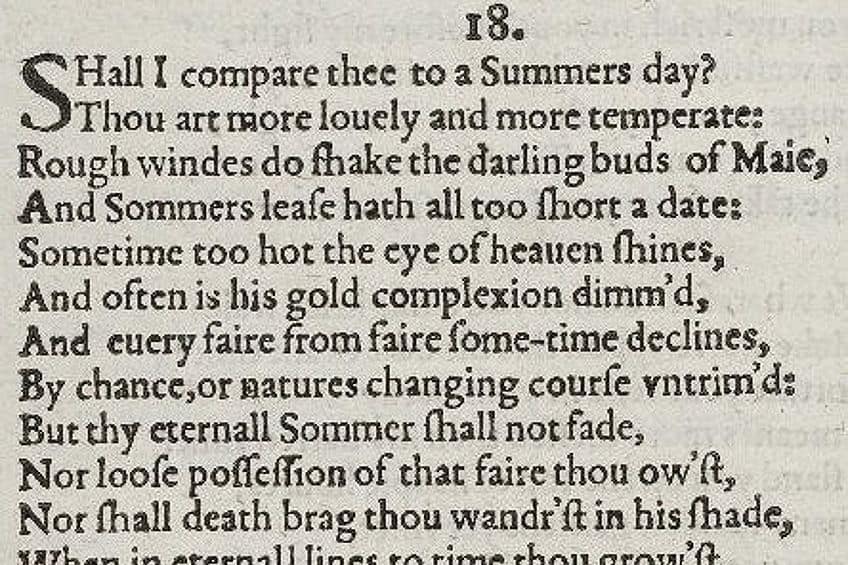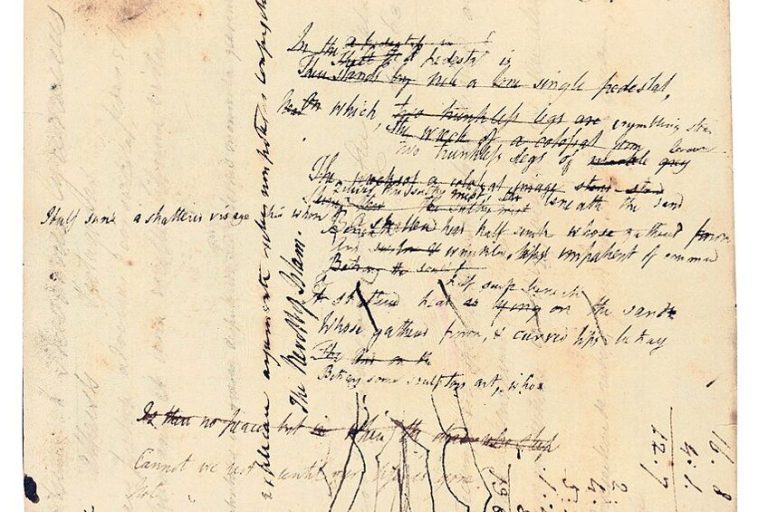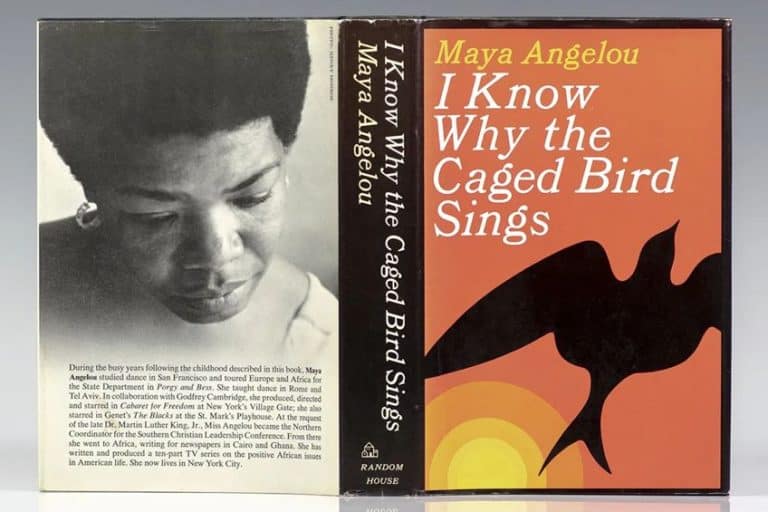Iambic Pentameter – Discover This Unique Poetic Meter
Poems with iambic pentameter have been around for a good few centuries and for very good reasons. However, iambic pentameter, much like poetic meter in general, can be difficult to grasp at first, and so this article will try to explain this concept. If your question happens to be “What is iambic pentameter in poetry?”, then this is the place for you! We are going to examine this form of meter in some detail, and we will even include a few iambic pentameter examples to help illustrate the concept. If you need some help understanding iambic pentameter, then keep reading to learn more!
A Look at Iambic Pentameter in Poetry
Meter is a common element of all poems. This term is used to refer to the beat of the syllables. While there certainly can be poems that do not make use of a more traditional metrical structure, like iambic pentameter, all poems do include this beat. All poems include words, all words include syllables, and so all poems have meter. When it comes to iambic pentameter, this just happens to be the most famous variety of meter. So, what is iambic pentameter in poetry?

The basic idea here has to do with the syllable count of a poem. When a poem makes use of a structure based around an unstressed followed by a stressed syllable, it is an example of an iambic poem. However, an iambic poem is not the same as iambic pentameter. The “iambic” part refers to an iamb, and this is the paired structure of two syllables where one is unstressed and the other is stressed. The number of iambs leads to the second part of the term.
The “pentameter” part combines the prefix “penta-“ with the suffix “-meter”, and “penta” means five. So, “iambic pentameter” is the term used to describe a poem that makes use of five iambs in each line. This means that each line has ten syllables. One unstressed, one stressed. This is an incredibly common type of meter, and we will examine some of why that is the case below, but it may be worth stating that this meter is often first attributed to Geoffrey Chaucer.
This means that iambic pentameter has been around for hundreds of years. It will probably stick around for as long as poetry exists.
Summary of Iambic Pentameter
Before we proceed with a more in-depth examination of poems with iambic pentameter and why this particular metrical structure is used, let us first have a brief summary of the concept. The reason for this is because some may not wish to read everything, and so a cliff-notes version will have to suffice:
- Iambic refers to the use of an unstressed-stressed syllable pair structure. This kind of metrical unit involves a pair of syllables, and each of these pairs is referred to as an iamb. There can be any number of iambs per line, and the “meter” signifier at the end tells us how many there are per line.
- Pentameter refers to the use of five metrical units per line. Once we have our type of meter, such as iambic, trochaic, and so on, we use a signifier of metrical number to say how many there are per line. In this case, there will be five metrical structures per line. So, iambic pentameter refers to five iambs in each line or ten syllables when all syllables are taken together.
- Iambic pentameter allows for more of a mimicry of ordinary speech. While every type of metrical structure has its own characteristics, iambic pentameter emulates natural speech in a way that others do not, and this can provide a poem with a more conversational style than may arise with other forms of meter.

If these few points are all that is needed, I wish you adieu. However, if you wish to learn more about iambic pentameter and, perhaps, even the answers to questions like: “What do all poems written in iambic pentameter have in common?” then let’s move on to the next section of this article to learn a little more about iambic pentameter in poetry.
The Characteristics and Purposes of Iambic Pentameter
Metrical structures can be found in all poems. This simply refers to the syllabic beat of a poem. How many syllables are there per line? How are those syllables arranged? Are they stressed or unstressed? Each of these questions allows us to determine whether or not we are dealing with one type of metrical structure or another, but we will go into some detail about how to specifically identify different metrical structures later in this article.
What exactly is it that iambic pentameter is able to accomplish for the poet and the reader? We have already mentioned, briefly, that this metrical structure involves the use of a paired structure of unstressed and stressed syllables in sets of five of these pairs per line. But what does this actually do to a poem? Why is this used?
It may be a very common form of meter and one that is used by many poems, but why?
One of the most basic reasons that iambic pentameter is used in poetry is because it emulates natural speech. When we speak in the English language, we tend to use an alternating pattern of unstressed and stressed syllables, and so any iambic poem is likely attempting to emulate this kind of flow. Other types of meter are often more “poetic” in a sense. They are unnatural and allow the reader to have a more disjointed experience when they are reading a text.
This results in poems with iambic pentameter having a more rhythmic flow. This can make iambic pentameter examples more enjoyable to read for many because they roll off the tongue in a far more satisfying way than some other types of meter. This can also allow for a more definitive structure to poems that use iambic pentameter, and it results in something far more traditional in general.
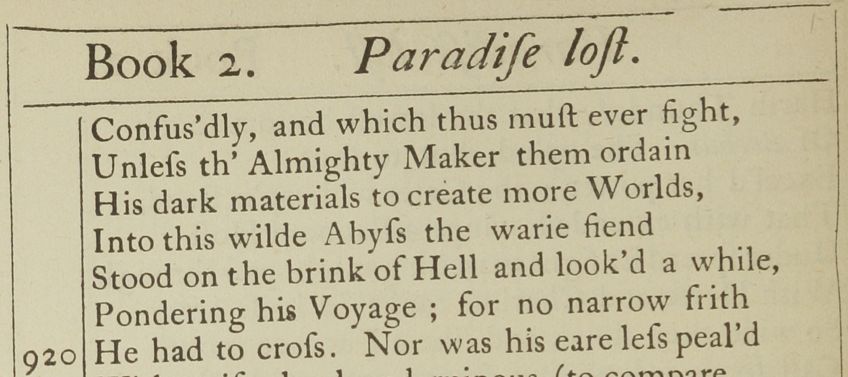
However, an interesting point is that there is often confusion between iambic pentameter and simple iambic poems. The “pentameter” part of the term refers to how many iambs are within each line, but many will refer to any poem that uses an unstressed-stressed pair structure as an example of iambic pentameter. All of these poems may be iambic poems, but they are not actually iambic pentameter poems. It is a common error that can be seen though and one that is understandable as iambic pentameter is probably the most widely taught metrical structure in English schools because of its close association with traditional English poetry, such as the work of William Shakespeare.
The Users of Iambic Pentameter
A great many poets have made use of iambic pentameter in their poetry over the centuries. The most famous of all of these poets is likely William Shakespeare. One of his poems will be discussed in one of the sections below, but it is worth noting here that his work has come to be strongly associated with iambic pentameter in general as every one of his sonnets made use of this metrical structure.
Other writers who notably made use of iambic pentameter include figures like John Milton, Alexander Pope, and William Wordsworth.
Many writers in the English language have made extensive use of poems with iambic pentameter because of the way in which rhythm and flow can be created through this particular type of metrical structure, and this has aided in reinforcing how common this type of meter is in the language. The more it is used by influential figures, the more likely it is to be used by later figures.

There are, for instance, many in the present day who continue to write iambic pentameter examples because of that more ordinary language capacity of the style. It is also, simply, a famous metrical structure, as has been mentioned, and so many will continue to use it well into the future.
However, if you are interested in being able to identify iambic pentameter in poetry yourself, it may be useful to understand a little about some of the other kinds of metrical structures out there. So, before we have a look at a few iambic pentameter examples to see notable instances of this metrical structure being used, let’s have a look at how we can identify meter in the first place.
Identifying Meter
When it comes to how to identify meter in a poem, there can be a lot of difficulty. It can be difficult to hear the stress of a syllable, and it can often involve sitting and sounding out each line of a poem to hear which syllables are elongated and stressed and which syllables are not. This is a skill that requires one to sit and work on it. You will only learn how to do it by putting in the work. And even then, there can sometimes be disputes on whether something is stressed or unstressed.
There is also the issue that stress on a syllable can be intentional.
What can be far easier to learn is syllable counting. As has been mentioned, the “pentameter” part of iambic pentameter refers to the number of metrical units in a line. “Iambic” refers to a paired structure of unstressed and stressed syllables, and in poems with iambic pentameter, there will be five of these iambic pairs in each line. However, we can see other kinds of syllable count.
Trimeter, seeing as it uses the prefix “tri-“, refers to a poem with three sets of a metrical unit. So, iambic trimeter would be a poem with three iambs per line for a total of six syllables on each line. It becomes as important to learn the different prefixes as it becomes to know what they mean. “Tetrameter” refers to four metrical units, “hexameter” refers to six metrical units, and so on.

So, while it can be difficult to identify stressed and unstressed syllables, it can often be easiest to start with simple syllable counting. You can count them with your fingers as you sound out each line of a poem. The more you practice, the better you’ll get. But that old mantra refers to pretty much everything, doesn’t it? But it really is true that if you want to get better at identifying meter, practice makes perfect.
Iambic Pentameter Examples
There are many different poems that have made use of iambic pentameter, but let’s have a look at a handful of examples to illustrate the concept. We are going to examine a few different poems with iambic pentameter. These three examples are only a small selection of the many different iambic pentameter examples in the world.
Nevertheless, it should give a general overview of the concept on display.
Sonnet 18: Shall I compare thee to a summer’s day? (1609) by William Shakespeare
| Date Published | 1609 |
| Type of Poem | Elizabethan sonnet |
| Rhyme Scheme | ABABCDCDEFEFGG |
| Meter | Iambic pentameter |
| Topic | Beauty and immortality |
Sonnet 18 or Shall I compare thee to a summer’s day? is one of the most famous of William Shakespeare’s poems. It is also entirely arguable that this is the most famous of all of his sonnets, and it is also a good iambic pentameter example. To be fair, every Shakespearean sonnet is likely a good example of iambic pentameter in general because it was the common meter of each and every one of his sonnets, but as this is the most famous of those sonnets, it may be easiest to use this one.
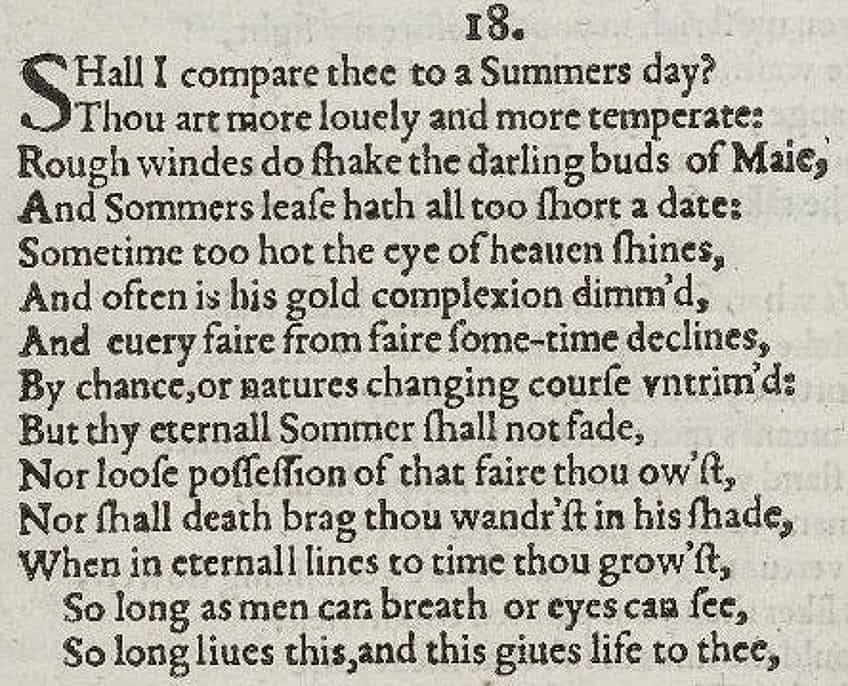
Every single line of the sonnet uses iambic pentameter, and this allows the poem to have a more naturalistic flow. Consider the very first line, from which the title arises, “Shall I compare thee to a summer’s day?”. This line uses ten syllables arranged in an unstressed-stressed paired beat structure to emulate human speech. It allows the poem to be more free-flowing and conveys everything it wishes in only one line of the poem.
This is one of the greatest benefits of iambic poems. When we ask ourselves a question like: “What do all poems written in iambic pentameter have in common?”, this is usually the answer. When there are fewer syllables per line, each line can feel more incomplete, but with lengthier lines, full thoughts can be produced. That is not to say that full thoughts cannot be produced with shorter lines, but less information per line can be used when there are fewer syllables.
So, it is simply beneficial to a poet for there to be more space available to convey the ideas they wish to express.
Ode to a Nightingale (1819) by John Keats
| Date Published | 1819 |
| Type of Poem | Ode |
| Rhyme Scheme | ABABCDECDE |
| Meter | Iambic pentameter |
| Topic | Beauty and nature |
Ode to a Nightingale is one of the most famous poems ever written by John Keats. This figure was already an immensely important one in the realm of Romantic literature, and this poem serves as a strong contender for the use of powerful and evocative imagery. This is another of the reasons for which iambic pentameter can often be used in poetry to strong effect because it allows for more space to create strong imagery.
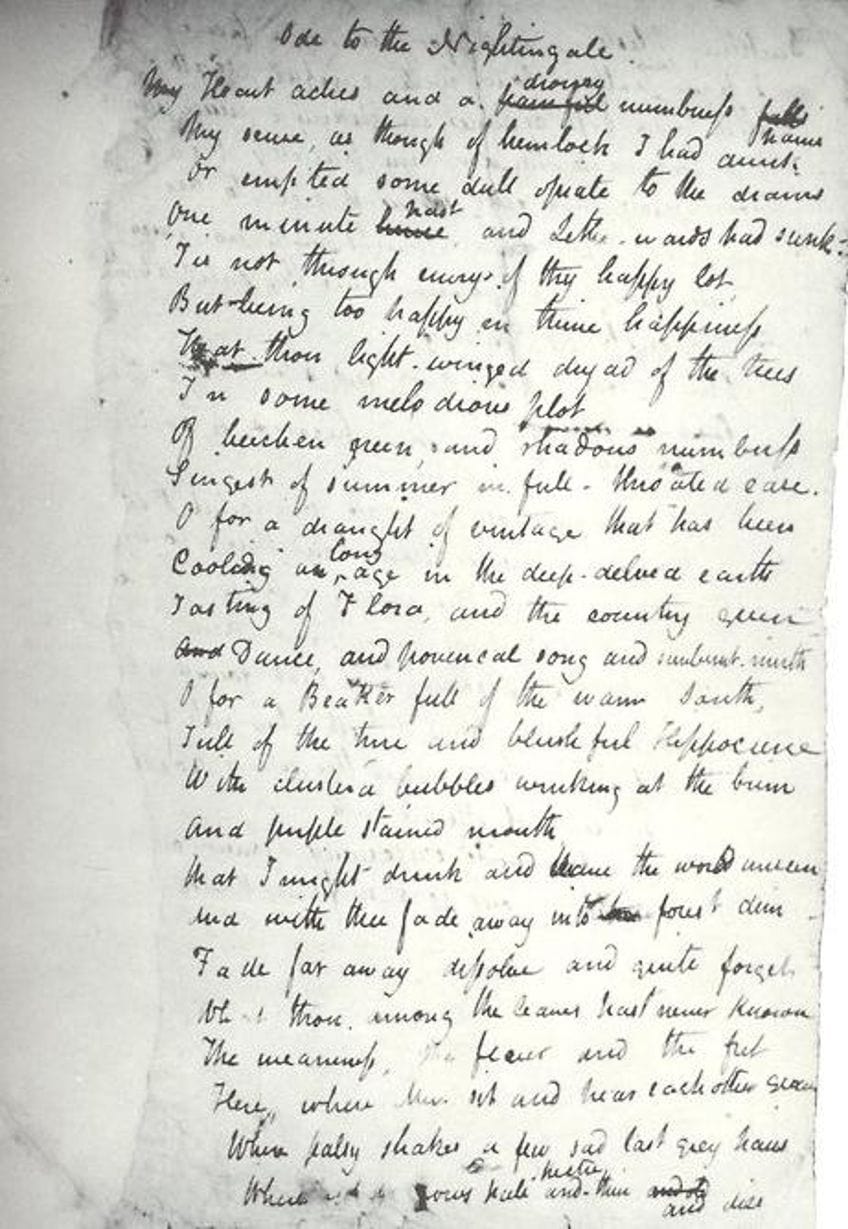
This particular poem is rather long too, as it involves eight separate stanzas, all of which are ten lines long, and so it is far lengthier than the sonnet discussed above. The poem is also explicitly set in a specific location. In this case, it’s set in the woods and a nightingale is nearby. The poem is, as the title suggests, dedicated to that particular bird as it sings through the trees for all to hear.
We can see the use of iambic pentameter in each stanza, but the first is good to open. We can see, for instance, from the first two lines, that enjambment is used: “My heart aches, and a drowsy numbness pains/my sense”. The one line leads directly into the next and should be read as a single sentence.
The allowance of more syllables becomes less important in general because we can simply read from one line to the next without pausing, but the additional space does allow for more imagery to be on display, and for the emotionality of it to shine through.
Grief (1844) by Elizabeth Barrett Browning
| Date Published | 1844 |
| Type of Poem | Petrarchan sonnet |
| Rhyme Scheme | ABBAABBA CDECDE |
| Meter | Iambic pentameter |
| Topic | Grief |
Grief is one of the most well-known and notable poems by Elizabeth Barrett Browning. Her work has become some of the best in the English language, and Grief is no exception to that. The poem is focused on what the title tells us: grief. This terrible human feeling has a sway over our minds and bodies, and how it can be an immensely overwhelming and all-encompassing feeling.
Much like the first example of Shakespeare’s famous sonnet, this poem is also a sonnet, but one written in the Petrarchan style. The style still makes use of iambic pentameter though and does so for similar reasons to those that have been discussed before. The poem uses a more conversational and personal style by opening with a first-person pronoun that directly addresses the audience as if we are friends or acquaintances.
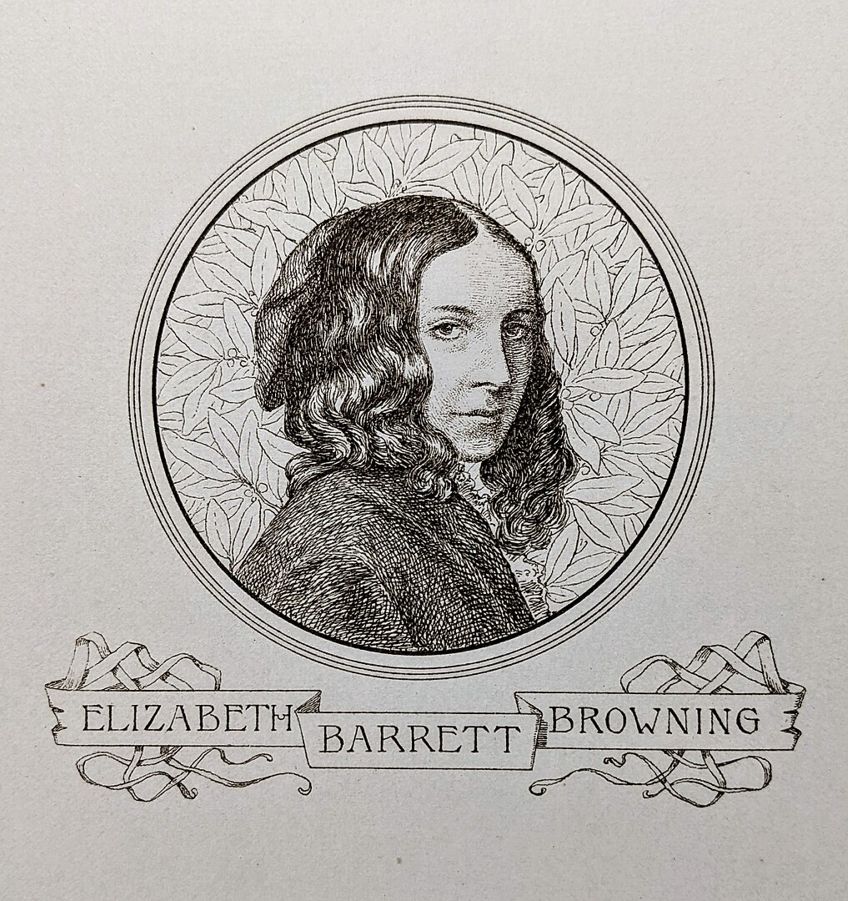
One of the upsides to iambic pentameter in poetry in general is that it sounds more natural. This poem also makes use of enjambment, like the previous example by John Keats, and this combination of a more personalized style and enjambment allows each line to flow into the next without there needing to be much of a reason for any kind of pause in the tale being told. Iambic pentameter simply flows in a pleasant way, and poems like this serve to show how that can be the case.
Where would we be without iambic pentameter? Well, we’d probably have a different kind of poetic meter to contend with, so we probably wouldn’t be all that far. However, we have had a look at iambic pentameter throughout this article, and we have even looked at a handful of iambic pentameter examples. This common metrical structure can be found in many poems and, hopefully, this article has aided you in being able to identify it when it shows up!
Frequently Asked Questions
What Is Iambic Pentameter in Poetry?
Iambic pentameter is a type of metrical structure. This refers to the syllabic beat of a poem. In the case of this particular type of meter, the stress of the syllables follows a two-syllable structure. There is one syllable that is unstressed and the next is stressed. This is what an iamb is, but as for the pentameter part of this structure, it refers to the number of iambs in a line. Each iamb is made up of two syllables and since penta means five, this indicates that there will be five iambs in each of these lines for a total of ten syllables.
What Kinds of Meter Are There Other Than Iambic Pentameter?
Iambic pentameter may be the most famous form of meter, but it is not the only variety. There are, of course, the different kinds of iambic poetry, such as iambic trimeter (three iambs, or six syllables). However, there are also varieties that are not iambic at all, such as trochaic meter (one stressed followed by a stressed syllable), or dactylic meter (one stressed syllable followed by two unstressed syllables). There are a variety of different types of meter that a poet could use.
What Do All Poems Written in Iambic Pentameter Have in Common?
The primary thing that iambic pentameter poems have in common is that they all incorporate the same metrical structure. This means that they all use the iambic syllable structure of one unstressed and one stressed syllable, and this tends to flow in a way that is reminiscent of natural language. This means that poems that have made use of iambic pentameter can often sound more natural in their presentation.
Which Poets Wrote in Iambic Pentameter?
When it comes to poets who have made use of iambic pentameter, you will find that many of them have made use of this metrical structure. Poets like William Shakespeare, Elizabeth Barrett Browning, John Keats, Percy Bysshe Shelley, Edna St. Vincent Millay, and many others have written iambic poems. This is one of the most common of all metrical structures and, in English, it is likely the most famous and consistently used, and so most have probably written using this form of meter.
Which Famous Poems Were Written in Iambic Pentameter?
There are a great many poems that can be considered perfect iambic pentameter examples. For instance, there are poems like Sonnet 18: Shall I compare thee to a summer’s day? (1609) by William Shakespeare, Ode to a Nightingale (1819) by John Keats, and Grief (1844) by Elizabeth Barrett Browning. However, there are so many poems that can be considered iambic poems, and, for that reason, there are definitely far more poems written in iambic pentameter than one would likely expect.
Justin van Huyssteen is a freelance writer, novelist, and academic originally from Cape Town, South Africa. At present, he has a bachelor’s degree in English and literary theory and an honor’s degree in literary theory. He is currently working towards his master’s degree in literary theory with a focus on animal studies, critical theory, and semiotics within literature. As a novelist and freelancer, he often writes under the pen name L.C. Lupus.
Justin’s preferred literary movements include modern and postmodern literature with literary fiction and genre fiction like sci-fi, post-apocalyptic, and horror being of particular interest. His academia extends to his interest in prose and narratology. He enjoys analyzing a variety of mediums through a literary lens, such as graphic novels, film, and video games.
Justin is working for artincontext.org as an author and content writer since 2022. He is responsible for all blog posts about architecture, literature and poetry.
Learn more about Justin van Huyssteen and the Art in Context Team.
Cite this Article
Justin, van Huyssteen, “Iambic Pentameter – Discover This Unique Poetic Meter.” Art in Context. November 16, 2023. URL: https://artincontext.org/iambic-pentameter/
van Huyssteen, J. (2023, 16 November). Iambic Pentameter – Discover This Unique Poetic Meter. Art in Context. https://artincontext.org/iambic-pentameter/
van Huyssteen, Justin. “Iambic Pentameter – Discover This Unique Poetic Meter.” Art in Context, November 16, 2023. https://artincontext.org/iambic-pentameter/.


